NCERT-Solutions-Class-6-Science-Light Shadows and Reflections
NCERT notes along with solutions for class 6: science – Chapter “Light Shadows and Reflections” are provided here. The notes as well as solutions are very much helpful for the students to understand the topic. The solutions will be handy for quickly completing the homework and preparing for exams.
Table of Contents
ToggleIntroduction: Light Shadows and Reflections
- During the daytime, our eyes see a wide range of things like colourful buildings, buses, cars, trees, plants, animals etc. But at night, when there is complete darkness, we don`t see these things. What is the reason? Have you ever thought about this?
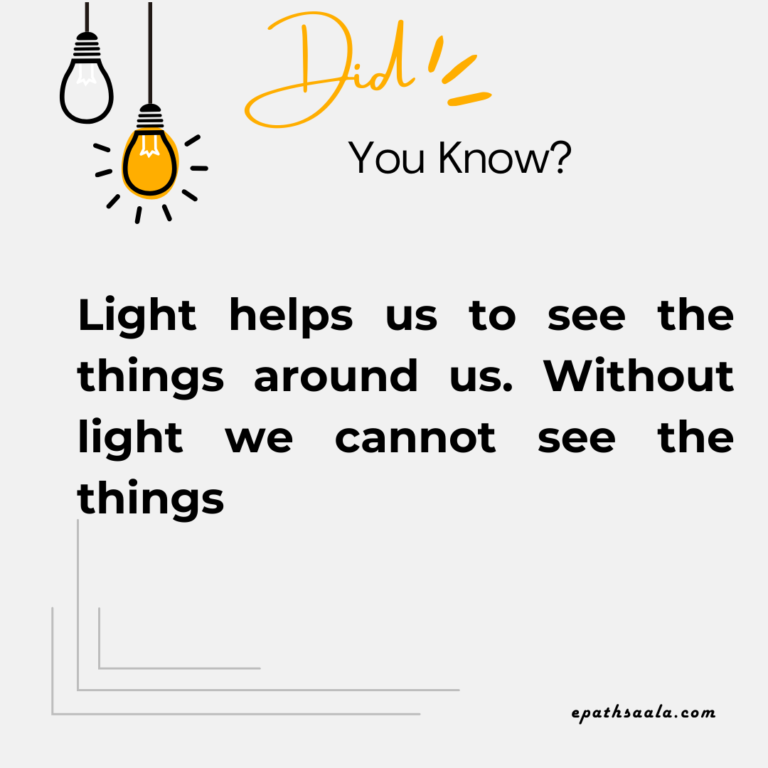
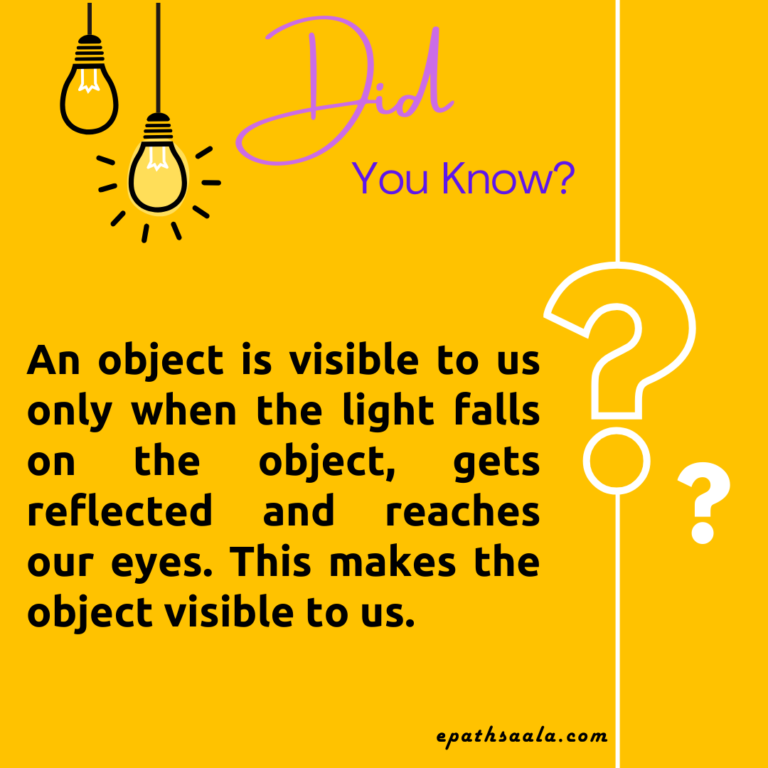
Light
- Light is a form of energy which helps us to see the things.
- Light always travels in a straight path in the form of rays.
- Light does not require any medium to travel.
Sources of light
- There are two sources of light.
- Natural Source: Sun, Stars, Firefly etc.
- Artificial Source: Torch, Bulb, Tubelight etc.
Luminous, Non-luminous and Bioluminescence
- Luminous bodies: Those bodies which give out or emit light of their own are called luminous objects like sun, stars etc.
- Non-luminous bodies: Those bodies which do not emit light of their own are called non-luminous bodies like book, wood, chair etc.
- Bioluminescence bodies: Emission of light by a living organism is called bioluminescence. For example – glow worm (Jugnu), firefly etc.
Transparent, Translucent and Opaque Objects
When light falls on an object three things happen:
- light may pass through the object almost completely.
- Only a portion of light may pass through the object.
- No amount of light may pass through the object.
- Transparent Object
- Translucent Object
- Opaque Object
Transparent Object :
- An object through which light can pass completely is called transparent objects.
- One can see through such medium clearly.
- Water, glass, air etc. are the examples of transparent objects.
- An object through which light can pass partially are called translucent object
- Translucent objects are also called semi-transparent objects.
- Translucent objects abosrb some light and allow the remaining light to pass through the object.
- Example – wax paper, tracing paper etc.
- Opaque objects which do not allow any light to pass through them are called opaque objects.
- One cannot see things through opaque objects.
- Opaque object either reflect or absorb most of the light falling on it.
- Opaque objects form a shadow when kept in the path of light.
- Example- wood, pencil, metal sheet etc.
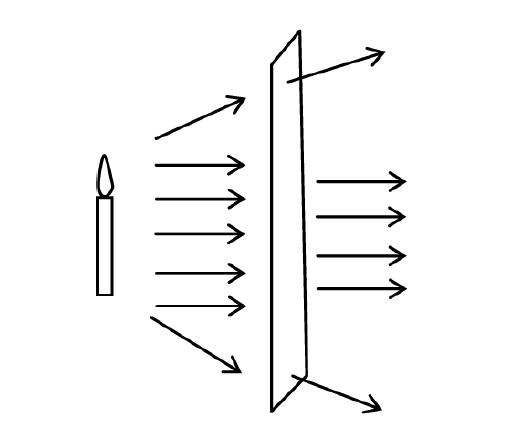
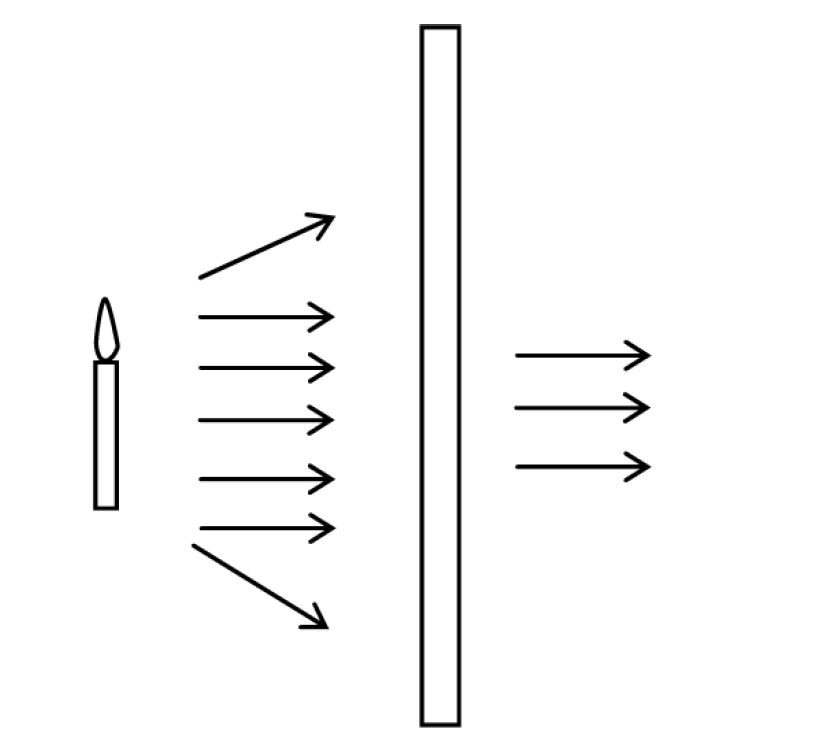
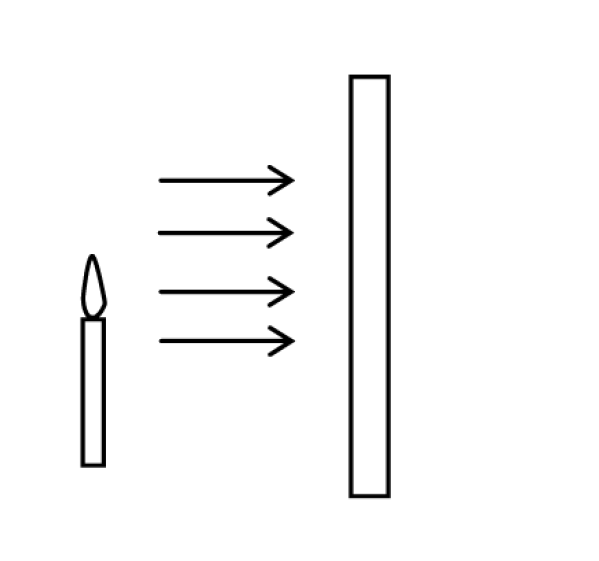
Shadow
- When an opaque object is placed between a source of light and a screen, it blocks the passage of light and casts a shadow on the screen.
- Three things required for the formation of a shadow:
- a source of light
- an opaque object
- a screen
Properties of a shadow
- A shadow is always created on the opposite side of the source of light.
- The distance between a source of light and an opaque object determines the size of the formed shadow.
- In some cases, the shadow formed can provide a lot of information about the object.
- Shadows are always black irrespective of the colour of the opaque object.
How the size of the shadow changes


Rectilinear propagation of light
- In a homogenous medium, light travels along a straight path and this property of light is known as rectilinear propagation of light.

Pinhole Camera
- A pinhole camera, also known as a camera obscura, is a simple optical imaging device that works on the principle of light projection. It contains no lens. It is a light-proof box with a small hole on one side. Light from the object goes through the pinhole and produces an inverted image in full colour on the screen. This is because only light from one point on the object can reach a given point on the screen.
- Changing the distance from the pinhole to the object will change the size of the image.
- If more than one pinhole is made in the end more than one image will be formed on the screen.
How to make a pinhole camera
- Take two cardboard boxes such that one can slide into another with no gap in between them.
- Cut open one side of each box.
- On the opposite face of the larger box, make a small hole in the middle.
- In the smaller box, cut out from the middle a square with a side of about 5 to 6 cm.
- Cover this open square in the box with tracing paper (translucent screen).
- Slide the smaller box inside the larger one with the hole, in such a way that the side with the tracing paper is inside.

Characteristics of the image formed by Pinhole camera
- The image formed is real and can be obtained only on the screen
- The image formed is inverted.
- The image is generally smaller in size than that of the object.
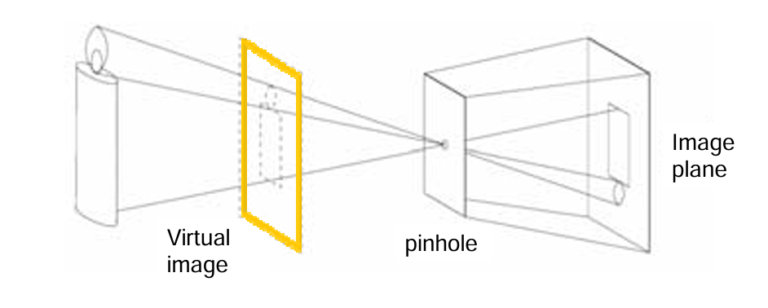
Natural Pinhole Camera
- When we pass under a tree covered with many leaves, we notice small patches of sunlight under it. These circular images are, in fact, pinhole images of the Sun. The gaps between the leaves, act as the pinholes. This is called a natural pinhole camera.
Mirror
- A polished or smooth surface (like glass) which forms image by reflection is known as a mirror.
- A mirror reflects light that falls on it.
- Plane mirrors are used as a looking glass.
Properties of an image formed by a plane mirror
- The image is upright.
- The image and the object are of the same size.
- The image is virtual and laterally inverted.
- The distance of the object from the mirror is equal to the distance of the image from the mirror.
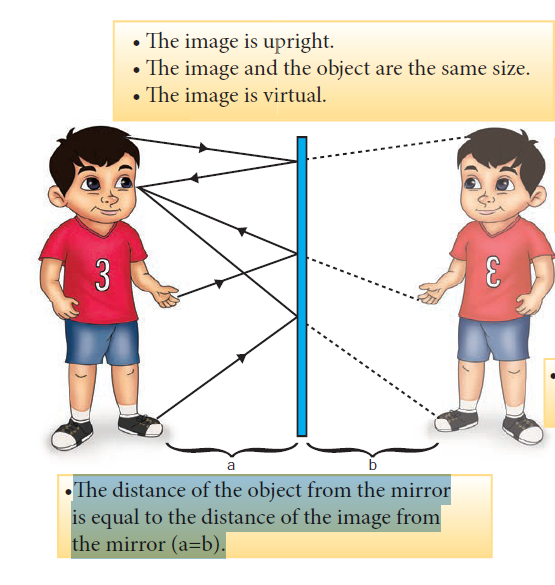
Reflection
- When light falls on a polished surface or a smooth surface (like mirror) it bounces back from the surface. This phenomenon of light is called reflections. Example – When a light falls on a mirror the light gets reflected.
Types of Reflection
- Regular reflection: When light falls on a polished or smooth surface, it bounces back from the surface in a well-defined direction. This phenomenon is called regular reflection.
- Diffuse reflection: when light falls on a non-polished surface, the non-polished surface also reflects light but in different directions. This type of spreading light in all directions is called diffuse reflection.
Laws of Reflection
- The angle of incidence is always equal to the angle of reflection i.e. ∠i = ∠r.
- The incident ray, the reflected ray and the normal at the point of incidence lie on the same plane.
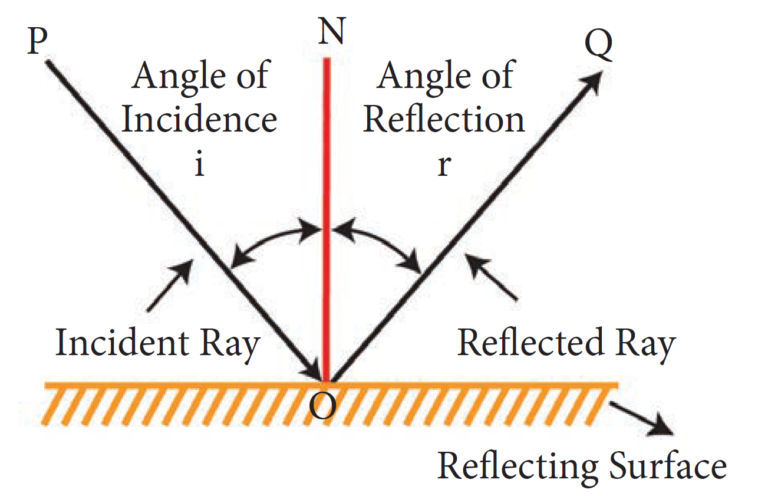
Meaning of terms used in the laws of reflection
- Incident ray: The ray of light that falls on the surface of the reflection materials. In the above picture, PO is the incident ray.
- Reflected ray: The ray of light that comes from the point when the incident ray falls on the reflection material. In the picture, OQ is the reflected ray.
- Point of incidence: The point at which incident ray strikes the reflecting surface is the point of incidence. In the picture ‘O’ point of incidence.
- Normal: The perpendicular line drawn from the point of incidence to the plane of reflecting surface is called normal. In the picture, ON is the normal.
- Angle of incidence: The angle formed between the incident ray PO and the normal ‘ON’ is angle of incidence. It is denoted by ∠i.
- Angle of reflection: The angle formed between the reflected ray OQ and the normal ON is angle of reflection. It is denoted by ∠r.
Activity of the exercise
Activity-1
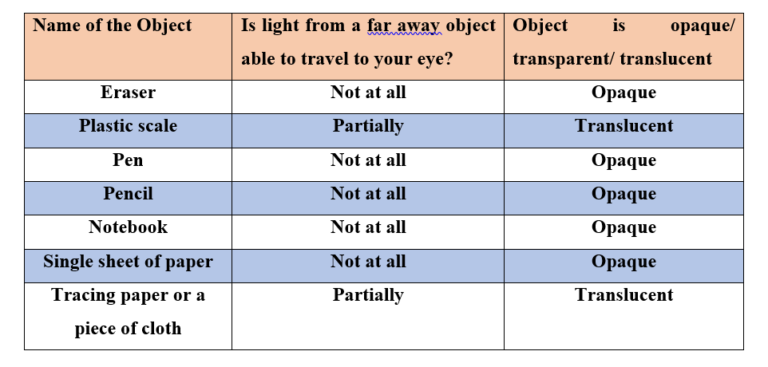
Activity-2
Do you observe a shadow in a dark room or at night when there is no light?
Sol:
No. Three things are required to form a shadow – a source of light, an opaque object and a screen. In this case, the source of light is absent. Hence, no shadow is observed.
Activity-3
Tell in this case whether a shadow will be formed or not?
1. Hold the torch close to the ground and shine it upwards so that its light falls on your friend`s face. If there were no screen behind your friend`s face, would you see the shadow of your friend`s head?
Sol:
No. Three things are required to form a shadow – a source of light, an opaque object and a screen. In this case, the screen is absent. Hence, no shadow is observed.
Activity-4
Place a chair in the school ground on a sunny day. What do you observe from the shadow of the chair? Does the shadow give an accurate picture of the shape of the chair? If the chair is turned around a little, how does the shape of the shadow change?
Sol:
No, the shadow does not accurately depict the shape of the chair. The shadow will show a different shape when the chair is slightly rotated since different parts of the chair will now block light and create shadows.
Activity-5
Tell whether the shadows formed by a thin notebook and a rectangular box seem to be similar?
Sol:
Yes, the two shadows will seem to be similar if the three things will be the same.
1. Shape of the objects
2. Distance between the source of light and the object.
3. Direction of light falling on the object.
Activity-6
Take flowers or other objects of different colours and look at their shadows (lets take a red rose and a yellow rose). Do the shadows look different in color when the colours of the objects are different?
Sol:
No, the shadows will always look in black colour even when the colours of the objects are different because the colour of the object does not affect the colour of the shadows.
Activity-7
Take a long box and look at its shadow on the ground. When you move the box around, you may see that the size of the shadow changes. When is the shadow of the box the shortest? when the long side of the box is pointed towards the sun or when the short side is pointing towards the sun?
Sol:
Shadow of the box is shortest when the short side of the box is pointing towards the sun.
Activity-8
Show in an experiment that light travels in a straight path.
Sol:
Take a long rubber tube. Light a candle and fix it on a table at one end of the room. Now standing at the other end of the room look at the candle through the tube. You will observe that when the tube is straight You can view the light of the candle and when the tube is bend (left or right or up or down) a little you cannot view the light of the candle.
This proves that light travels in a straight line.
Solution of the exercise
Q1. Rearrange the boxes given below to make a sentence

Q2. Classify the objects or materials given below as opaque, transparent or translucent and luminous or non-luminous:
Air, water, a piece of rock, a sheet of aluminium, a mirror, a wooden board, a sheet of polythene, a CD, smoke, a sheet of plane glass, fog, a piece of red hot iron, an umbrella, a lighted fluorescent tube, a wall, a sheet of carbon paper, the flame of a gas burner, a sheet of cardboard, a lighted torch, a sheet of cellophane, a wire mesh, kerosene stove, sun, firefly, moon.
Ans:2
|
Object/ Materials |
Opaque/Transparent/ Translucent Objects |
Luminous/ Non-luminous |
|
Air |
Transparent |
Non-luminous |
|
Water |
Transparent |
Non-luminous |
|
A piece of work |
Opaque |
Non-luminous |
|
A sheet of aluminium |
Opaque |
Non-luminous |
|
A Mirror |
Opaque |
Non-luminous |
|
A wooden board |
Opaque |
Non-luminous |
|
A sheet of polythene |
Translucent |
Non-luminous |
|
A CD |
Opaque |
Non-luminous |
|
Smoke |
Translucent |
Non-luminous |
|
A sheet of plane glass |
Transparent |
Non-luminous |
|
Fog |
Translucent |
Non-luminous |
|
A piece of red hot iron |
Opaque |
Luminous |
|
An umbrella |
Opaque |
Non-luminous |
|
A lighted fluorescent tube |
Opaque |
Luminous |
|
A wall |
Opaque |
Non-luminous |
|
A sheet of carbon paper |
Opaque |
Non-luminous |
|
The flame of a gas burner |
Translucent |
Luminous |
|
A sheet of cardboard |
Opaque |
Non-luminous |
|
A lighted torch |
Opaque |
Luminous |
|
A sheet of cellophane |
Translucent |
Non-luminous |
|
A wire mesh |
Translucent |
Non-luminous |
|
Kerosene stove |
Opaque |
Luminous |
|
Sun |
Opaque |
Luminous |
|
Firefly |
Opaque |
Luminous |
|
Moon |
Opaque |
Non-luminous |
Q3. Can you think of creating a shape that would give a circular shadow if held in one way and a rectangular shadow if held in another way?
Ans:3
- A cylindrical object will give a circular shadow if held in one way and a rectangular shadow if held in another way.
- When the top of the cylinder lies towards the light, then the shadow formed will be circular in shape.
- When the side of the cylinder lies towards the light, then shadow formed will be rectangular in shape.
Q4. In a completely dark room, if you hold up a mirror in front of you, will you see a reflection of yourself in the mirror?
Ans:4
No, we will not be able to see our reflection in the mirror because there is no source of light in the room.